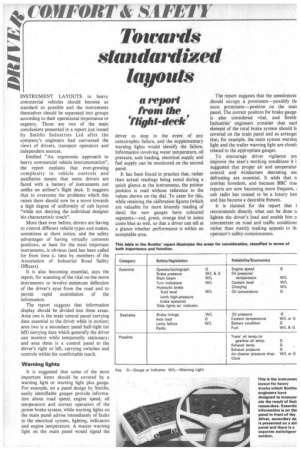Towards standardized • layouts
Page 78

If you've noticed an error in this article please click here to report it so we can fix it.
a report.
from the
INSTRUMENT LAYOUTS in heavy commercial vehicles should become as standard as possible and the instruments themselves should be separated into groups according to their operational importance or urgency. Those are two of the main conclusions presented in a report just issued by Smiths Industries Ltd after the company's engineers had canvassed the views of drivers, transport operators and independent sources.
Entitled "An ergonomic approach to heavy commercial vehicle instrumentation", the report explains that ever-growing complexity in vehicle controls and auxiliaries means that some drivers are faced with a battery of instruments not unlike an airliner's flight deck. It suggests that to overcome the problems which this raises there should now be a move towards a high degree of uniformity of cab layout "while not denying the individual designer his characteristic touch".
More than ever before, drivers are having to control different vehicle types and makes, sometimes at short notice, and the safety advantages of having virtually common positions, at least for the most important instruments, is obvious (and has been called for from time U, time by members ,of the Association of Industrial Road Safety Officers).
It is also becoming essential, says the report, for scanning of the vital on-the-move instruments to involve minimum deflection of the driver's eyes from the road and to permit rapid assimilation of the information.
The report suggests that information display should be divided into three areas. Area one is the main central panel carrying data essential to the drivdr while in motion; area two is a secondary panel half-right (or left) carrying data which generally the driver can monitor while temporarily stationary; and area three is a control panel to the driver's right or left, carrying switches and controls within his comfortable reach.
Warning fights It is suggested that some of the most important items should be covered by a warning light or warning light plus gauge. For example, on a panel design by Smiths, easily identifiable gauges provide information about road speed, engine speed, oil temperature and correct operation of the power brake system, while warning lights on the main panel advise immediately of faults in the electrical system, lighting, indicators and engine temperature. A master warning light on the main panel would signal the Wigist-deek!
driver to stop in the event of any catastrophic failure, and the supplementary warning lights would identify the failure. Information involving water temperature, oil pressure, axle loading, electrical supply and fuel supply can be monitored on the second panel.
It has been found in practice that, rather than actual readings being noted during a quick glance at the instruments, the pointer position is read without reference to the values shown on the dial To cater for this, while retaining the calibration figures (which are valuable for more leisurely reading of data) the new gauges have coloured segments—red, green, orange and in some cases blue as well, so that a driver can tell at a glance whether performance is within an acceptable area. The report suggests that the speedornete should occupy a prominent—possibly thi most prominent—position on the mail panel. The correct position for brake gauge: is also considered vital, and Smith: Industries' engineers consider that eaci element of the total brake system should bi covered on the main panel and so arranger that, for example, the main system warnim light and the trailer warning light are closell related to the appropriate gauges.
To encourage driver vigilance an improve the man's working conditions it i suggested that proper air and temperatur control and windscreen demisting an defrosting are essential. It adds that u combat boredom, and because BBC road reports are now becoming more frequent, cab radio has ceased to be .a luxury iten and has become a desirable fitment.
It is claimed for the report that i recommends directly what can be done ti lighten the driver's load and enable him u concentrate on road and traffic conditions rather than merely making appeals to th operator's safety-consciousness.






























































































































